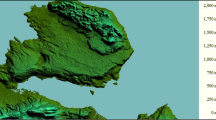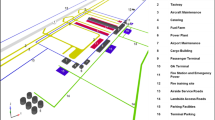Abstract
Atatürk International Airport (AIA) hosts the most crowded air traffic in Turkey. It is located to the south of the city in an urban area. A new airport is under construction in the north of Istanbul, which is a rural site. All commercial operations of AIA are going to be moved to the new airport after the completion of the construction. Aircraft emissions have adverse impact on ambient air quality, especially at urban sites. In this study, aircraft emissions from LTO cycles were estimated in AIA. NOx, CO, and HC emissions were 4249, 2153, and 181 t year−1, respectively. Taxi phase was responsible for the vast majority of CO and HC emissions. The majority of NOx emissions occurred from climb phase. Valuation of the emissions was estimated according to their unit damage price. The total damage value was 9,420,848 € year−1. NOx contributed more than 99% of the total amount. Dispersion of the pollutants was modeled with EPA’s AERMOD. The calculated NOx and CO concentrations at the closest air quality monitoring station to the airport were compared with the observed results. The contribution of aircraft emissions to NOx and CO concentrations at the station was 5.1 and 2.4%, respectively. The annual limit value of NOx was exceeded in most of the airport area and the residential area to the west of the airport. The highest concentration was 566 μg m−3, which was estimated at the parking/gate area. The maximum daily 8-h mean concentration of CO exceeded the limit value only at the gates and parking area.







Similar content being viewed by others
Change history
30 January 2018
The original publication’s Fig. 6 caption was incorrectly written as “Fig. 6 Distribution of annual NOx concentrations (a). Distribution of annual NOx concentrations (b). Distribution of 8-h CO concentrations (c)”.
References
Anderson BE, Chen G, Blake DR (2006) Hydrocarbon emissions from a modern commercial airliner. Atmos Environ 40:3601–3612. https://doi.org/10.1016/j.atmosenv.2005.09.072
Balter BM, Faminskaya MV (2017) Irregularly emitting air pollution sources: acute health risk assessment using AERMOD and the Monte Carlo approach to emission rate. Air Qual Atmos Health 10:401–409. https://doi.org/10.1007/s11869-016-0428-x
Barrett SRH, Britter RE (2009) Algorithms and analytical solutions for rapidly approximating long-term dispersion from line and area sources. Atmos Environ 43:3249–3258. https://doi.org/10.1016/j.atmosenv.2009.03.032
Deary ME, Uapipatanakul S (2014) Evaluation of the performance of ADMS in predicting the dispersion of sulfur dioxide from a complex source in Southeast Asia: implications for health impact assessment. Air Qual Atmos Health 7:381–399. https://doi.org/10.1007/s11869-013-0225-8
EEA (2013) EMEP/EEA Air Pollutant Emission Inventory Guidebook. http://www.eea.europa.eu/publications/emep-eea-guidebook-2013
Elbir T (2008) Estimation of Engine emissions from commercial aircraft at a midsized Turkish airport. J Environ Eng 134:210–215. https://doi.org/10.1061/(ASCE)0733-9372(2008)134:3(210)
European Directive (2008) Directive 2008/50/EC of the European Parliament and of the Council of 21 May 2008 on Ambient Air Quality and Cleaner Air for Europe
Flightradar 24 (2016). http://www.flightradar24.com. Accessed 17 Oct 2016
GDSAA (2015) General Directorate of State Airports Authority Annual Report. Ankara, Turkey
GDSAA (2016) General Directorate of State Airports Authority Annual Statistics. http://www.dhmi.gov.tr/istatistik.aspx. Accessed 22.09 2016
Herndon SC et al (2004) NO and NO2 emission ratios measured from in-use commercial aircraft during taxi and takeoff. Environ Sci Technol 38:6078–6084. https://doi.org/10.1021/es049701c
ICAO (1993) Environmental Protection: Annex, 16, Vol. II, Aircraft Engine Emissions
ICAO (1995) Engine exhaust emissions databank, 1st edition, Montreal
ICAO (2013) Sustainability facts and figures. http://www.icao.int/sustainability/Pages/FactsFigures.aspx. Accessed 22.09 2016
Kara M, Mangir N, Bayram A, Elbir T (2014) A spatially high resolution and activity based emissions inventory for the metropolitan area of Istanbul, Turkey. Aerosol Air Qual Res 14:10–20. https://doi.org/10.4209/aaqr.2013.04.0124
Kesgin U (2006) Aircraft emissions at Turkish airports. Energy 31:372–384. https://doi.org/10.1016/j.energy.2005.01.012
Maibach M et al (2008) Handbook on estimation of external costs in the transport sector. Delft
Masiol M, Harrison RM (2014) Aircraft engine exhaust emissions and other airport-related contributions to ambient air pollution: a review. Atmos Environ 95:409–455. https://doi.org/10.1016/j.atmosenv.2014.05.070
Mazaheri M, Johnson GR, Morawska L (2011) An inventory of particle and gaseous emissions from large aircraft thrust engine operations at an airport. Atmos Environ 45:3500–3507. https://doi.org/10.1016/j.atmosenv.2010.12.012
Ozkurt N (2014) Current assessment and future projections of noise pollution at Ankara Esenboğa Airport, Turkey. Transp Res Part D: Transp Environ 32:120–128. https://doi.org/10.1016/j.trd.2014.07.011
Ozkurt N, Sari D, Akdag A, Kutukoglu M, Gurarslan A (2014) Modeling of noise pollution and estimated human exposure around İstanbul Atatürk Airport in Turkey. Sci Total Environ 482–483:486–492. https://doi.org/10.1016/j.scitotenv.2013.08.017
Peace H, Maughan J, Owen B, Raper D (2006) Identifying the contribution of different airport related sources to local urban air quality. Environ Model Softw 21:532–538. https://doi.org/10.1016/j.envsoft.2004.07.014
Pecorari E, Mantovani A, Franceschini C, Bassano D, Palmeri L, Rampazzo G (2016) Analysis of the effects of meteorology on aircraft exhaust dispersion and deposition using a Lagrangian particle model. Sci Total Environ 541:839–856. https://doi.org/10.1016/j.scitotenv.2015.08.147
Perl A, Patterson J, Perez M (1997) Pricing aircraft emissions at Lyon-Satolas airport. Transp Res Part D: Transp Environ 2:89–105. https://doi.org/10.1016/S1361-9209(97)00005-9
Simonetti I, Maltagliati S, Manfrida G (2015) Air quality impact of a middle size airport within an urban context through EDMS simulation. Transp Res Part D: Transp Environ 40:144–154. https://doi.org/10.1016/j.trd.2015.07.008
Spicer CW et al (2009) Rapid measurement of emissions from military aircraft turbine engines by downstream extractive sampling of aircraft on the ground: results for C-130 and F-15 aircraft. Atmos Environ 43:2612–2622. https://doi.org/10.1016/j.atmosenv.2009.02.012
Stettler MEJ, Eastham S, Barrett SRH (2011) Air quality and public health impacts of UK airports. Part I: emissions. Atmos Environ 45:5415–5424. https://doi.org/10.1016/j.atmosenv.2011.07.012
Turgut ET et al (2015) A gaseous emissions analysis of commercial aircraft engines during test-cell run. Atmos Environ 116:102–111. https://doi.org/10.1016/j.atmosenv.2015.06.031
Unal A, Hu Y, Chang ME, Talat Odman M, Russell AG (2005) Airport related emissions and impacts on air quality: application to the Atlanta International Airport. Atmos Environ 39:5787–5798. https://doi.org/10.1016/j.atmosenv.2005.05.051
USEPA (2004) AERMOD: description of model formulation. EPA 454/R-03-004 September 2004 Nurth Carolina, USA
Vijay Bhaskar B, Jeba Rajasekhar RV, Muthusubramanian P, Kesarkar AP (2008) Measurement and modeling of respirable particulate (PM10) and lead pollution over Madurai, India. Air Qual Atmos Health 1:45–55. https://doi.org/10.1007/s11869-008-0004-0
Yim SHL, Stettler MEJ, Barrett SRH (2013) Air quality and public health impacts of UK airports. Part II: impacts and policy assessment. Atmos Environ 67:184–192. https://doi.org/10.1016/j.atmosenv.2012.10.017
Acknowledgements
The author would like to thank to Marmara Clean Air Center and Ministry of Environment and Urbanization owing to operating the air quality monitoring station and sharing the ambient air pollutant concentrations.
Author information
Authors and Affiliations
Corresponding author
Additional information
The original version of this article was revised: Figure 6 caption was changed from “Distribution of annual NOx concentrations (a). Distribution of annual NOx concentrations (b). Distribution of 8-h CO concentrations (c)” to “(a) Distribution of 8-hr CO concentrations (b) Distribution of annual NOx concentrations (c) Distribution of annual HC concentrations”
A correction to this article is available online at https://doi.org/10.1007/s11869-018-0552-x.
Rights and permissions
About this article
Cite this article
Kuzu, S.L. Estimation and dispersion modeling of landing and take-off (LTO) cycle emissions from Atatürk International Airport. Air Qual Atmos Health 11, 153–161 (2018). https://doi.org/10.1007/s11869-017-0525-5
Received:
Accepted:
Published:
Issue Date:
DOI: https://doi.org/10.1007/s11869-017-0525-5




